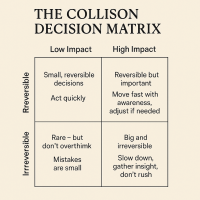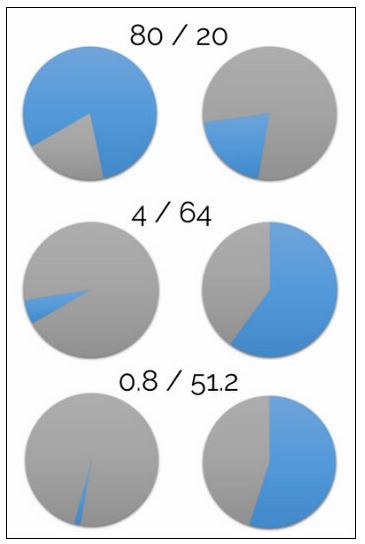The Fat Tail Fractal Factor
Learn How To Benefit From The Fat Tail Fractal Factor
Less than 1% of your efforts and resources can deliver over 50% of your results
Introducing the Fat Tail Fractal Factor
One of the pleasures of writing material for this site is that I get to research subjects that are new to me. The mental models
section falls into this category. I have gained many new insights from
this research and the area that I have found most instructive can be
broadly categorized as chance, probability and statistics.
For a non-statistically trained lay person such as myself, this has introduced a whole new dimension to my understanding of life and has added more tools to my balanced toolkit.
In layman's terms - what exactly is the fat tail fractal factor?
We are all familiar with the 80/20 rule [also know as the Pareto Principal] which basically means that as a general observation 80% of your results come from 20% of your efforts. So the take away with this is to focus your time, energy and resources on that productive 20% to maximise your results.
What you may not know, and I certainly didn't, is that that the 80/20 rule can be applied to itself - that's what the fractal factor means.
So 20% of your 20% best efforts [i.e. 4%] will deliver 64% of your best results. This is illustrated in the second line of the graphic above.
And the 80/20 rule can be applied to this 4% so 20% of that 4% [i.e. 0.8%] will deliver 51.2% of your best results. This illustrated in the third line of the graphic above.
So in very simple terms this means that:
1% of your efforts and resources can deliver 50% of your results!
The challenge lies in finding that key subset of your productive 20%.
In this article I want to share some insights I gained from learning how to apply the fat tail fractal factor and find that elusive 1%. But first, an anecdote:
My first experience of the fat tail fractal factor
Early in my career as a salesman I worked for the marketing services division of the credit reporting agency Dun & Bradstreet. My sales target was £10,000 per month and over the first 6 months I consistently managed to achieve target.
My
average order value was about £1,000 and this involved a huge amount of
cold-calling and about 1,000 miles of driving every week to achieve the
10 orders to make my sales target.
I realised that there had to be a more efficient way of working as there was no way I could maintain that workload over the long term, so I decided to aim for one order worth £10,000 per month.
Although I had never heard of the 80/20 rule, that is exactly what I applied. I thought carefully about the type of client that had a big enough requirement to order in that quantity. I figured out that this had to be a client who had a requirement for added value services, so in addition to selling the raw data I decided to sell the additional services required to fulfill a direct mail or telesales campaign.
The following month I smashed my target with an order for £10,000 and then repeated that success the following month.
As I basked in the warm glow of this early success it occurred to me that the only difference between a £10,000 order and a £100,000 order was an extra zero. So all I had to do was figure out what type of client could place an order of that size.
Further analysis revealed that if I could create a bespoke lead generation service for one of the major financial services companies who employed thousands of salesmen trying to sell pension schemes to small business owners then I could achieve this. Whilst I was obviously unaware of it at the time I was then applying the fat tail fractal factor.
Fast forward another two months and I had approached the regional director of one of these financial services companies and secured an order for £100,000. This covered most of my annual sales target, and I then repeated this process on a smaller scale with a couple of other clients and I closed that financial year on sales of £250,000.
The effect of that first big sale was totally disproportionate to the effort I expended on winning it:
- Achieved the largest single order that had ever been achieved in that division.
- Became top salesman of that year.
- Promoted to Business Development Manager
- Earned £40,000 in commission which adjusted for inflation is £200,000 [or $265,000 USD].
2 Key Ideas That Underpin the Fat Tail Fractal Factor
[1] The Power Law
A power law describes a relationship between two things in which a change in one thing can lead to a large change in the other, regardless of the initial quantities.
Statistically it also describes a range of variations from the mean that can be very large.
[2] The Fat Tail
The fat tail is the 80% of result that comes from the 20% of effort.
Statistically, there is a relatively high probability of extreme outcomes in the fat tail.
Clearly the fat tail is where all the serious action is, and the fat tail fractal factor describes the scenario where the effort applied to the critical 1% will yield a massive return that is totally disproportionate to effort invested.
Exceptions and Qualifications to The Fat Tail Fractal Factor
There are circumstances where 80% of your return may not be derived from 20% of your efforts. When we talk about the "fat tail" we are referring to markets and situations where there is a greater-than-expected probability of extremely high values [i.e, revenues and profit]. However, we also have to consider the "long tail" which is about almost limitless opportunities to create/sell/distribute bespoke/niche products or services in low volumes and at high profit. A typical example of this is the phenomenal growth of online business reflecting the much lower costs of marketing and distribution coupled with changing consumer preference that has led to the growth of high profit, low volume, niche products and services. The effect of this is to expand the "long tail" and reduce the amount of revenue and profit derived from the "fat tail". This means that there are situations where, for example, 50% or less of your desired outcomes [e.g. revenue and profit] are derived from the "fat tail" and 50% or more from the "long tail". When this occurs, the 80/20 rule would now be the 50/50 rule or 40/60 rule! Qualifying the application of the fat tail fractal factor [1] As a general observation does the 80/20 principle apply to your situation? Is approximately 80% of your desired outcome [e.g. revenue and profit] derived from approximately 20% of your effort? [2] If the answer to that question is "No", then we can expand the 80/20 criteria to consider 3 further important qualifications - is there: [Factors that could cause a concentration of control of distribution or influence on decision making behaviour could be legislative, technical, brand related, social media/influencers or any number of other factors.] If none of this applies then the 80/20 rule, and thus the fat tail fractal factor, does not apply to your situation.
As you focus on the top 20%, you know that somewhere in amongst that
group is a subset - which may be just one or two individuals - who will
deliver over 50% of your results. Here are 5 practical tips that I have used, and continue to use, to find that critical 1%: [1] Focus on Quality Not Quantity [2] Attract Luck - Be The Best At What You Do [3] Hunt With A Rifle Not A Shotgun [4] Accept the Failure Rate [5] Play The Long Game The fat tail fractal factor is not just about business and money.
This is applies to relationships, hobbies, and areas of special interest to
you. If you can master the dynamics of making this happen you can take a quantum leap in your personal effectiveness, in any area of life that really matters to you, and make a big difference in the lives of others.
How To Find That Critical 1%
Closing Reflections
Further Reading:
The Pareto Principle - the 80/20 Rule
Understanding Complex Systems Thinking - It's Not Complicated
Why Understanding Ergodicity Is Critical To Your Long Term Survival
How Positive Asymmetry Can Transform Your Life
How To Benefit From The Unseen Margins
Third Party Resource:
The Real Meaning of 80/20 - The Rise Of The Fat Tail
Next Article: Dunbar's Number
Return from the "Fat Tail Fractal Factor"
to: Walking The Talk
Or to: Mental Models
LATEST ARTICLES
The Battle For Your Mind - How To Win Inner Freedom In A Digital Age Of Distraction
 From External Events to Inner Events. We often think of “events” as things that happen out there: the traffic jam, the rude comment, the delayed email reply. But what truly shapes our experience is wh…
From External Events to Inner Events. We often think of “events” as things that happen out there: the traffic jam, the rude comment, the delayed email reply. But what truly shapes our experience is wh…How to See Your Thoughts Without Becoming the Story
 A Practical Guide to Thought-Awareness. You can spend your life inside the stories of your mind without ever learning how to see your thoughts clearly and objectively. Most of the stuff we tell oursel…
A Practical Guide to Thought-Awareness. You can spend your life inside the stories of your mind without ever learning how to see your thoughts clearly and objectively. Most of the stuff we tell oursel…The Collison Decision Matrix - A Simple Framework for Better Choices
 The Collison Decision Matrix Is A Practical Everyday Thinking Tool. Most of us spend a surprising amount of time worrying about decisions. From small ones such as what to wear, what to eat, what to te…
The Collison Decision Matrix Is A Practical Everyday Thinking Tool. Most of us spend a surprising amount of time worrying about decisions. From small ones such as what to wear, what to eat, what to te…The Power Of Asking The Right Question
 The Power Of Asking The Right Question Lies In The Quest For Insight. To experience the power of asking the right question you must develop the practice of asking questions. The best way to improve th…
The Power Of Asking The Right Question Lies In The Quest For Insight. To experience the power of asking the right question you must develop the practice of asking questions. The best way to improve th…Site Pathways
 Here is a site pathway to help new readers of Zen-Tools navigate the material on this site. Each pathway is based around one of the many key themes covered on this site and contain a 150 word introduc…
Here is a site pathway to help new readers of Zen-Tools navigate the material on this site. Each pathway is based around one of the many key themes covered on this site and contain a 150 word introduc…How To Live With Contradiction - Beyond Thought Let Stillness Speak
 A major impact on so many peoples' lives is the situational contradiction of unfilled realistic expectations. So where does all this leave us? Well here we are, with mental equipment that is more lim…
A major impact on so many peoples' lives is the situational contradiction of unfilled realistic expectations. So where does all this leave us? Well here we are, with mental equipment that is more lim…How To Trust The Process Of Mindfulness - Right Now
 In mindfulness, the process isn’t some distant goal — it's what is happening right now. When we talk about how to trust the process of mindfulness the credibility of the process is heavily dependent…
In mindfulness, the process isn’t some distant goal — it's what is happening right now. When we talk about how to trust the process of mindfulness the credibility of the process is heavily dependent…Inner Mastery For Outer Impact - Mental Clarity For Effective Action
 Insights only matter if they translate into consistent action. In a world crowded with quick fixes and motivational soundbites, the theme “Inner Mastery for Outer Impact” calls us to something more e…
Insights only matter if they translate into consistent action. In a world crowded with quick fixes and motivational soundbites, the theme “Inner Mastery for Outer Impact” calls us to something more e…The Wise Advocate - Helping You Achieve The Very Best Outcome
 The focus of your attention in critical moments of choice either builds or restricts your capacity for achieving the best outcome. When we talk of 'The Wise Advocate' its easy to think of the consigl…
The focus of your attention in critical moments of choice either builds or restricts your capacity for achieving the best outcome. When we talk of 'The Wise Advocate' its easy to think of the consigl…Trust The Process - Beyond The Cliche
 The phrase "trust the process" has become a cliche, the woo-woo mantra of the "self help" industry. Those three little words feel like they ought to mean something useful but hidden behind them are a…
The phrase "trust the process" has become a cliche, the woo-woo mantra of the "self help" industry. Those three little words feel like they ought to mean something useful but hidden behind them are a…The Dopamine Delusion - Why Anticipation Beats Achievement
 The thrill we feel is not in the having, but in the wanting. The more we have, the more we want. The more things we acquire and the easier things get for us, the more discontent we feel. The more spo…
The thrill we feel is not in the having, but in the wanting. The more we have, the more we want. The more things we acquire and the easier things get for us, the more discontent we feel. The more spo…The Power Of Silence Is Experienced In Your Use Of Language
 Practise the "Beneficial Neurological Delay" for optimal comprehension. The power of silence is experienced in your use of language, specifically: - How you formulate the words you use to think and in…
Practise the "Beneficial Neurological Delay" for optimal comprehension. The power of silence is experienced in your use of language, specifically: - How you formulate the words you use to think and in…


